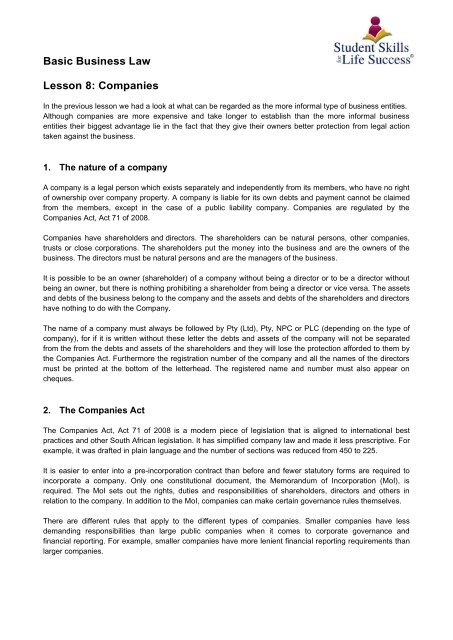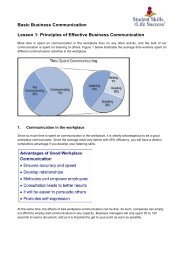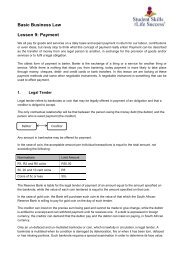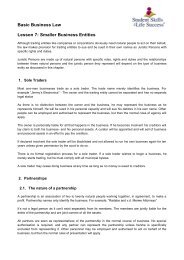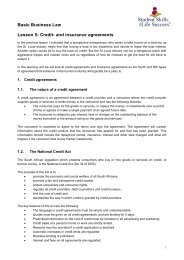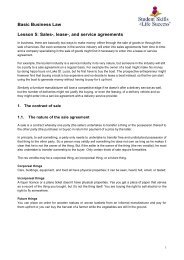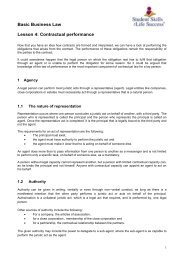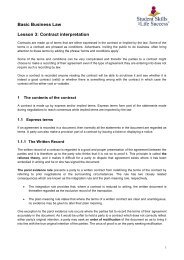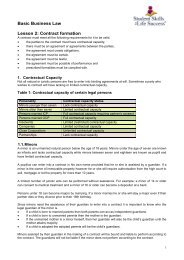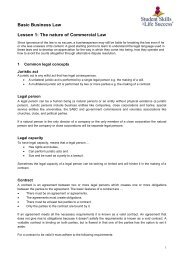Basic Business Law. Lesson 8. Companies
This is the eighth lesson of the "Student Skills for Life Success" "Basic Business Law" course. The topics covered in this booklet are: 1. The nature of a company 2. The Companies Act 3. The Companies and Intellectual Property Commission 4. Types of companies 5. Forming a company 6. Trading as a private company 7. Shareholder meetings 8. Duties and rights of directors 9. Private companies in financial distress
This is the eighth lesson of the "Student Skills for Life Success" "Basic Business Law" course. The topics covered in this booklet are:
1. The nature of a company
2. The Companies Act
3. The Companies and Intellectual Property Commission
4. Types of companies
5. Forming a company
6. Trading as a private company
7. Shareholder meetings
8. Duties and rights of directors
9. Private companies in financial distress
Create successful ePaper yourself
Turn your PDF publications into a flip-book with our unique Google optimized e-Paper software.
<strong>Basic</strong> <strong>Business</strong> <strong>Law</strong><br />
<strong>Lesson</strong> 8: <strong>Companies</strong><br />
In the previous lesson we had a look at what can be regarded as the more informal type of business entities.<br />
Although companies are more expensive and take longer to establish than the more informal business<br />
entities their biggest advantage lie in the fact that they give their owners better protection from legal action<br />
taken against the business.<br />
1. The nature of a company<br />
A company is a legal person which exists separately and independently from its members, who have no right<br />
of ownership over company property. A company is liable for its own debts and payment cannot be claimed<br />
from the members, except in the case of a public liability company. <strong>Companies</strong> are regulated by the<br />
<strong>Companies</strong> Act, Act 71 of 200<strong>8.</strong><br />
<strong>Companies</strong> have shareholders and directors. The shareholders can be natural persons, other companies,<br />
trusts or close corporations. The shareholders put the money into the business and are the owners of the<br />
business. The directors must be natural persons and are the managers of the business.<br />
It is possible to be an owner (shareholder) of a company without being a director or to be a director without<br />
being an owner, but there is nothing prohibiting a shareholder from being a director or vice versa. The assets<br />
and debts of the business belong to the company and the assets and debts of the shareholders and directors<br />
have nothing to do with the Company.<br />
The name of a company must always be followed by Pty (Ltd), Pty, NPC or PLC (depending on the type of<br />
company), for if it is written without these letter the debts and assets of the company will not be separated<br />
from the from the debts and assets of the shareholders and they will lose the protection afforded to them by<br />
the <strong>Companies</strong> Act. Furthermore the registration number of the company and all the names of the directors<br />
must be printed at the bottom of the letterhead. The registered name and number must also appear on<br />
cheques.<br />
2. The <strong>Companies</strong> Act<br />
The <strong>Companies</strong> Act, Act 71 of 2008 is a modern piece of legislation that is aligned to international best<br />
practices and other South African legislation. It has simplified company law and made it less prescriptive. For<br />
example, it was drafted in plain language and the number of sections was reduced from 450 to 225.<br />
It is easier to enter into a pre-incorporation contract than before and fewer statutory forms are required to<br />
incorporate a company. Only one constitutional document, the Memorandum of Incorporation (MoI), is<br />
required. The MoI sets out the rights, duties and responsibilities of shareholders, directors and others in<br />
relation to the company. In addition to the MoI, companies can make certain governance rules themselves.<br />
There are different rules that apply to the different types of companies. Smaller companies have less<br />
demanding responsibilities than large public companies when it comes to corporate governance and<br />
financial reporting. For example, smaller companies have more lenient financial reporting requirements than<br />
larger companies.
Other features of the Act are the following:<br />
• Shareholders have extensive rights to obtain information from the<br />
company.<br />
• A higher degree of accountability is demanded from directors.<br />
• Transparency is improved through stakeholder participation rules.<br />
• High standards of corporate governance are encouraged.<br />
• Minimum accounting standards is set for annual reports.<br />
• There are stricter provisions governing directors’ conduct and liability.<br />
• <strong>Companies</strong> are classified as either profit or non-profit companies.<br />
• Take-overs and fundamental transactions are strictly regulated.<br />
• <strong>Companies</strong> are allowed to merge into one new entity, provided that both companies are in a<br />
financially sound position in that they have more assets than liabilities and can pay their debts<br />
as the fall due.<br />
• Provision is made for a modern business rescue regime.<br />
• There is a move towards the decriminalisation of company law and the establishment of bodies<br />
for the effective enforcement of the legislation.<br />
• Minority shareholders and other stakeholders, such as employees, have better protection,<br />
powers, and remedies under the Act, including the ability to bring class actions.<br />
• Provision is made for new insolvency laws.<br />
• An act of a company is not void anymore solely because the company did not have the capacity<br />
to do the act, or the directors did not have the authority to perform the act on behalf of the<br />
company.<br />
• <strong>Companies</strong> are specifically prohibited from reckless, negligent, or fraudulent trading and<br />
persons who were knowingly a party to such conduct are guilty of an offence.<br />
3. The <strong>Companies</strong> and Intellectual Property Commission<br />
The <strong>Companies</strong> and Intellectual Property Commission (CIPC) was established in terms of section 185 of the<br />
<strong>Companies</strong> Act when the Office of <strong>Companies</strong> and Intellectual Property Enforcement (OCIPE) and the<br />
<strong>Companies</strong> and Intellectual Property Registration Office (CIPRO) amalgamated in 2010.<br />
The CIPC receives its directives from the Minister of Trade and Industry. It’s a juristic person that functions<br />
as an organ of state within the public administration but outside the public service.<br />
The main functions of the Commission are to …<br />
• register companies, co-operatives and intellectual property rights,<br />
• disclose information on its register,<br />
• promote awareness of, company and intellectual property law,<br />
• promote compliance with the relevant legislation,<br />
• ensure the efficient and effective enforcement of the legislation,<br />
• monitor compliance with and contraventions of financial reporting standards, and make<br />
recommendations in this regard and<br />
• report to, conduct research for, and advise the Minister of Trade and Industry, on matters of<br />
national policy relating to company and intellectual property law.
4. Types of companies<br />
4.1. Non-Profit <strong>Companies</strong><br />
Non-Profit <strong>Companies</strong> are incorporated for a public benefit purpose, including cultural or social activities,<br />
communal interest, or group interest.<br />
The income and property may not be distributed to the incorporators, members, directors, or officers, but<br />
they may be reasonably compensated for services rendered. The MoI must be completed and signed by a<br />
minimum of three persons, called incorporators and a minimum of three directors must be appointed.<br />
All of a non-profit company’s assets and income must be used to advance its stated objectives and the name<br />
of a non-profit company must end with “NPC”. The distribution of residual assets is restricted on the<br />
dissolution of a non-profit company. For example, if a NPC is dissolved and there is money left, this money<br />
cannot go to the members of the NPC, but must be donated to another NPC.<br />
Membership can be held by juristic persons including profit companies and the votes of members have equal<br />
standing unless it is otherwise indicated by the MoI.<br />
Example<br />
The South African Guide-Dogs Association is an NPC that has been in operation in South Africa since 1953.<br />
They train guide dogs for the blind and service and social dogs for the physically disabled. These dogs<br />
provide the beneficiaries with independence, mobility and companionship.<br />
They also train sighted students as Orientation and Mobility practitioners. These practitioners return to their<br />
communities and train blind people to enable them to become independent and mobile. It costs a lot of<br />
money and time to train the dogs over an 18 month period and the recipients only pay a nominal R5 plus<br />
R100 board and lodging when they receive their dogs. As such the South African Guide-Dogs Association<br />
rely on the financial support of private individuals, corporates and service groups. The South African Guide-<br />
Dogs Association receives no government funding.<br />
4.2. Profit <strong>Companies</strong><br />
Profit companies can take one of four different forms: a state-owned company, a public company, a private<br />
company, and a personal liability company.<br />
4.2.1. State-owned companies<br />
State-owned companies are treated separately from other companies because there might be legislation that<br />
pertains to them specifically that are not in line with the general provisions of the <strong>Companies</strong> Act and<br />
persons doing business with the State should be aware of these other laws. The name of a state-owned<br />
company must end with the expression “SOE Ltd.”.<br />
4.2.2. Public companies<br />
Public companies are not state-owned companies and the name of a public company must end with the word<br />
“Limited” or its abbreviation, “Ltd.”. The incorporators of a public company must consist of at least one<br />
person and a public company must have at least three directors. The person(s) doing the incorporation can<br />
be a juristic person or a natural person.
The MoI of a public company permits the company to offer shares to the public but<br />
restricts the director’s right of pre-emption. This means that the directors of a public<br />
company don’t have control over the shares that was issued.<br />
4.2.3. Private companies<br />
Private companies are not state-owned companies and the name of a private company must end with the<br />
words “Proprietary Limited” or its abbreviation [Ply] Ltd. Private companies are subject to fewer disclosure<br />
and transparency requirements than public companies.<br />
The MOI of a private company will prohibit it from offering any of its securities to the public and will restrict<br />
the transferability of its securities. There is no longer a limit on the number of shareholders and the shares of<br />
a private company will only be indicated as a percentage value of the total.<br />
A private company must have at least one director and each incorporator is regarded as a first director of the<br />
company.<br />
4.2.4. Personal Liability <strong>Companies</strong><br />
A personal liability company is a company that meets the criteria for a private company and its MOI states<br />
that it is a personal liability company and that the directors & past directors are jointly and severally liable<br />
together with the company, for the debts & liabilities of the company that were contracted during their<br />
respective terms of office. Its name must end with the word “Incorporated” or its abbreviation “Inc.”.<br />
5. Forming a company<br />
The formation of a company is an action by persons in the exercise of their constitutional right to freedom of<br />
association combined with their common law right to contract. Therefore, the incorporation of a company is a<br />
right, not a privilege granted by the State and so the Act places minimal requirements on the incorporation of<br />
a company.<br />
A company is incorporated by the adoption of a memorandum of Incorporation (MoI). The MoI is the sole<br />
governing document of the company. The Act imposes certain specific requirements on the content of a MoI<br />
which are necessary to protect the interests of shareholders in the company. It further provides a number of<br />
default rules which companies may accept or alter as they wish to meet their needs and serve their interests.<br />
Anyone who wants to incorporate a company can go to a legal practitioner for assistance, but otherwise this<br />
application can be made to CIPC directly on a standard form of MoI which permits the incorporators to<br />
accept the required provisions, as well as the default provisions with or without alteration.<br />
6. The advantages and disadvantages of trading as a private company<br />
The main advantages of a private company over a partnership or sole trader are that the life span of the<br />
private company will be continuous, and the shareholders will have limited liability. Directors could be held<br />
liable though if they knowingly do business in a reckless or fraudulent manner.<br />
Other advantages are that it is easy to transfer ownership and, it is easier to raise capital for a private<br />
company than for a partnership or a sole trader. The business structure also doesn’t have to be adapted if<br />
the business grows really big.
The major disadvantages of a private company are that it is subject to many legal<br />
requirements and it is difficult and expensive to establish compared to a<br />
partnership or sole proprietorship. A private company will also face stiffer financial rules, especially as it gets<br />
bigger.<br />
The MoI of a private company restricts the right to transfer its shares and prohibit any offer to the public for<br />
the subscription of any shares or debentures of the company. A private company cannot, therefore, be listed<br />
on the stock exchange.<br />
7. Shareholder meetings<br />
Shareholders get an opportunity to exercise their oversight role at the Annual General Meeting (AGM). A<br />
public company must convene an AGM once every calendar year, within 15 months of the previous AGM.<br />
While private companies are not required to convene an AGM, it remains a good practice to do so in any<br />
case.<br />
Public companies must give notice of a shareholder’s meeting at least 15 business days before the meeting,<br />
while in the case of private companies it is 10 business days.<br />
Physical attendance is not mandatory, and meetings may be conducted entirely by electronic<br />
communication. Alternatively, only some members may participate electronically. The only requirement is<br />
that they must be able to communicate simultaneously. Shareholders who cannot attend a meeting in person<br />
or electronically, can give someone else a written proxy. The person with the proxy can then attend on their<br />
behalf and the proxy will be valid for one year.<br />
During the AGM, the directors’ report, the audit committee’s report and the audited financial statements for<br />
the preceding financial year must be presented. The meeting must also deal with the election of directors,<br />
the appointment of the auditor and audit committee for the following year, and any other matter raised by a<br />
shareholder, with or without advance notice to the company.<br />
Resolutions can be passed at the AGM or another shareholders meeting or it may also be submitted to the<br />
shareholders for consideration and the shareholders may then vote on that matter in writing within 20<br />
business days alter the resolution was submitted to them.<br />
Example<br />
“Big Plans Travel Agency” has ten shareholders with equal shares in the company. At the AGM of the<br />
company the following resolution is proposed:<br />
“We the shareholders of “Big Plans Travel Agency (Pty) LTD” resolve to appoint “Eagle Eye Auditors” as the<br />
auditors of the company for the next three years.”<br />
Rule 1: In order to hold a legal AGM (i.e. have a quorum) 25% of the voting shares must be represented at<br />
the AGM.<br />
In this case that means that least 3 of the shareholders must be present. As there are 4 shareholders<br />
present (i.e. 40% of the voting shares), the meeting can go ahead.<br />
Rule 2: To pass an ordinary resolution requires 51% of the voting rights being exercised, while a special<br />
resolution will require 75%.
The appointment of the auditors requires only an ordinary resolution. Only 40% of<br />
the voting rights are being exercised. The rule states that 51% of the voting rights<br />
being exercised must be in favour of the resolution in order for it to pass.<br />
In this case that means that 3 of the four shareholders present must be in favour (i.e. 75%) as 50% (i.e. 2 out<br />
of four) will not be enough to pass the resolution.<br />
<strong>8.</strong> Duties and rights of directors<br />
Directors are required to disclose any “personal financial interests”. They may not use their position as<br />
director or information gained as a director to make a secret profit or gain advantage for themselves or<br />
someone else or to cause harm or detriment to the company.<br />
The Act deals comprehensively with the election, disqualification, vacancies, removal, meetings, resolutions,<br />
and liabilities of directors.<br />
The common law is and remains the primary source of director’s duties. Although, in practice, the MoI<br />
prescribes the extent of the directors' powers and a director who acts outside the ambit of the MoI will be<br />
answerable to the company for his conduct. The function of the law is to supplement and add detail to the<br />
responsibilities of directors as contained in the MoI and to deal with areas on which the MoI is silent.<br />
At common law a director owes two types of duty to the company, a fiduciary duty and a duty of skill and<br />
care.<br />
<strong>8.</strong>1. The fiduciary duty of a director<br />
A fiduciary is a person who is in a special position of trust. A director is a fiduciary and therefore must act in<br />
good faith in his dealings with or on behalf of the company and he must exercise the powers and fulfil the<br />
duties of his office honestly. A director cannot be relieved of his fiduciary duties by agreement or by any<br />
other means. Any act amounting to an evasion of his duty is seen in the same light as a breach of the duty<br />
itself.<br />
The fiduciary duty has four aspects. Firstly a director has a duty to act in good faith and do what he honestly<br />
believes is in the best interests of the company. Secondly a director must not use his powers for improper<br />
purposes, even if he believes that to do so would be in the best interests of the company. In addition he must<br />
exercise his powers as director for the benefit of the company and for the purpose of which they were<br />
conferred.<br />
Further a director must not put himself in a position where there is an actual or potential conflict between his<br />
duty to the company and his personal interests and lastly a director is regarded as a trustee of company<br />
property, and he must not knowingly participate in or ignore the misapplication of company property.<br />
<strong>8.</strong>2. The director’s duty to display a reasonable level of skill and care<br />
When a director is acting in the company's interests he is to exercise whatever skill he possesses and<br />
reasonable care.
A director is not expected to exercise a level of skill he does not have. The level of<br />
skill required of a director is subjective. He is not expected, merely by virtue of his<br />
office, to possess any particular skills. His performance will be judged by the way he applies any skills which<br />
he actually has.<br />
However, in the case of an insolvent company a director incurs personal liability for wrongful trading if he<br />
does not display both the general knowledge, skill, and experience that he actually has and that which might<br />
be reasonably expected of someone carrying out his function within the company.<br />
The degree of care required is different for executive and non-executive directors. The non-executive director<br />
must display the same care a layman might be expected to take in the same circumstances on his own<br />
behalf. By contrast, an executive director's service contract will normally stipulate that he must devote his full<br />
attention to the business of the company.<br />
<strong>8.</strong>3. Statutory duties<br />
The common law principles governing a director's conduct set out above are amplified by a range of specific<br />
duties imposed by the Act. These duties are listed below.<br />
• A director must disclose any interest in a contract or proposed contract with the company.<br />
• A director must notify the company on his appointment of his interests in shares and debentures<br />
of the company and other companies in its group. The company must also be notified of<br />
subsequent changes in these interests.<br />
• The register of members, the minutes of general meetings, the register of directors and<br />
secretaries as well as the directors' service contracts must be maintained by every company<br />
and must be available for inspection by the members.<br />
• Every company must file an annual return signed by a director or the secretary with CIPC.<br />
• A company must not make loans to its directors or persons connected with them.<br />
• The directors must ensure that the financial statements are laid open for inspection at the<br />
annual general meeting.<br />
<strong>8.</strong>3.1. The right to manage and bind the company.<br />
When a director deals with a third party, and the third party acts in good faith, the power of the director to<br />
bind the company is unlimited. Therefore, to all intents and purposes, the directors have the power to enter<br />
into contracts and agreements with third parties and the company will be bound by those contracts, even<br />
though the director in question may be acting outside the scope of his authority.<br />
Even though directors are not limited in their dealings with the outside world, their powers can be limited by<br />
the MoI. These limitations will not affect third parties but may make the director responsible to the company<br />
for his actions. The members of a company may ratify action) any action of a director which exceeds his<br />
authority. That means they may authorise the director after the action and honour the agreement that the<br />
director entered into in its entirety.<br />
<strong>8.</strong>3.2. Additional duties of directors of listed companies<br />
The Board of Directors of companies listed on the Johannesburg Stock exchange has additional duties<br />
coming out of the King Reports on corporate governance. These make good guidelines for all other<br />
companies aiming for good corporate governance. These boards have the duties to …<br />
• provide strategic direction and retain full and effective control,
• comply with laws and regulations,<br />
• define levels of materiality (see example <strong>8.</strong>3)),<br />
• delegate certain powers to management and reserve other powers to itself,<br />
• have access to company information and records,<br />
• agree a procedure to allow directors to obtain independent professional advice<br />
• decide on the number of directors required to make the Board effective,<br />
• identify and monitor key risk and key performance areas,<br />
• identify and monitor non-financial aspects, like the company’s impact on the environment,<br />
• record facts and assumptions which lead it to conclude that the business will be a going concern<br />
in the next financial year and state what steps are taken if not,<br />
• explain the effect of all proposed resolutions to be passed at shareholders meetings,<br />
• encourage shareowners to attend general meetings,<br />
• ensure the Chairperson of the Audit and Remuneration Committees and as many directors as<br />
possible attend shareholders meetings,<br />
• provide CV's of all directors who are to be appointed,<br />
• have a board charter setting out its responsibilities and<br />
• determine a balance between governance constraints and entrepreneurial performance.<br />
Example<br />
The board must draft statements that say which amounts, transactions, or discrepancies are significant<br />
enough to require further explanation.<br />
For example, it is normal for any company to have bad debts, and once these are indicated they would<br />
normally require no further explanation. But if most of the bad debt can be attributed to a single transaction<br />
and the amount is above the threshold amount that was indicated in the materiality statement, then the<br />
directors will have to explain what happened to the shareholders.<br />
9. Private companies in financial distress<br />
If the directors of a company have reasonable grounds to believe that the company is in financial distress,<br />
they must either …<br />
• place the company under <strong>Business</strong> Rescue or<br />
• liquidate the company or<br />
• send a notice to all shareholders, creditors, employees and trade unions that the company is in<br />
financial problems and give reasons why the company is not liquidated or placed under<br />
<strong>Business</strong> Rescue.<br />
9.1. <strong>Business</strong> Rescue<br />
<strong>Business</strong> rescue is largely a self-administered regime by the company, in consultation with all the<br />
stakeholders. For example, the employees might agree to accept lower salaries for a time or the creditors<br />
can agree to wait for payment in an attempt to save the business. It is however independently supervised<br />
and is subject to court intervention at any time on application by any of the stakeholders.<br />
The stakeholders which are recognised and allowed to participate in the development and approval of a<br />
<strong>Business</strong> Rescue (BR) plan include the shareholders, creditors and employees of the company.<br />
The interests of employees and workers are protected by the following measures:<br />
• They are recognised as creditors of the company with a voting interest.
• They are consulted in the development of the BR plan.<br />
• They are given an opportunity to address creditors before a vote on<br />
the plan.<br />
• As a group, they have the right to buy out any uncooperative creditor or shareholder.<br />
BR proceedings begin when the board passes a resolution for voluntarily BR proceedings, or when an<br />
affected person, such as a shareholder, creditor, employee, or organised labour, applies to the court for BR<br />
proceedings. For a company to qualify for the BR process, no liquidation proceedings must have<br />
commenced against the company. The process includes the following steps:<br />
• Within five days after passing the resolution, the company must appoint a BR practitioner and<br />
publish the notice as prescribed.<br />
• The company must then file the appointment of the BR practitioner with CIPC and inform all<br />
affected parties of the appointment.<br />
During BR proceedings, no legal proceedings may commence or proceed against the company and the<br />
directors of the company can only act with the authority of the BR practitioner.<br />
The BR practitioner will file a BR termination notice when the BR plan has been rejected or when the BR<br />
plan has substantially been implemented. If the BR plan is rejected liquidation proceedings will start.<br />
9.2. Liquidation<br />
Liquidation is the process by which a company is brought to an end, and the assets and property of the<br />
company redistributed and may either be compulsory or voluntary.<br />
Voluntary liquidation happens when the members of the company resolve to voluntarily wind-up the affairs of<br />
the company and dissolve and begins when a resolution to the effect is passed. The company will generally<br />
cease to do business at that time. If the company is solvent the liquidation will proceed as a members'<br />
voluntary winding-up.<br />
When the company is unable to pay its debts as they fall due, the company or any other stakeholder can<br />
approach the court and apply for the liquidation of the company. The main purpose of a liquidation where the<br />
company is insolvent is to collect in the company's assets, determine the outstanding claims against the<br />
company, and satisfy those claims in the manner and order prescribed by law.<br />
Generally, the priority of claims on the company's assets will be in the following order:<br />
1. Liquidators’ costs<br />
2. Creditors with security over assets<br />
3. Costs incurred by an administrator.<br />
4. Amounts owing to employees for wages and salaries.<br />
5. Amounts owing in respect of workers' injuries.<br />
6. Amounts owing to employees for leave.<br />
7. Retrenchment payments owing to employees.<br />
<strong>8.</strong> Creditors without security over assets<br />
9. Shareholders<br />
Example<br />
When Troublesome Times Tours (Pty) Ltd required a loan from ABC Bank, The Bank demanded that they<br />
provide some security on the loan and the directors decided to offer the shares the company had in another<br />
profitable company as security. As such the share certificate was handed to the bank for safekeeping.
If the company is now liquidated, ABC Bank will be treated as a creditor with<br />
security over the assets of the company. This means that they will be paid first and<br />
will properly be able to recover the full amount owed to them when the shares are sold as part of the<br />
liquidation of the company.<br />
Creditors without security over assets will have to take their place in the line of creditors and will only get<br />
back a portion of what was owed to them, expressed as a certain amount of cents in the rand. For example,<br />
the liquidated assets (money) is proportionally divided among the creditors without security over assets and<br />
all of these get 10c for every rand that was owed to them. The rest of the money will then have to be written<br />
off as bad debt.<br />
When the company's affairs have been wind up, the liquidator will call a final meeting of the stakeholders and<br />
send the final accounts of the company to CIPC. The company is then dissolved.


